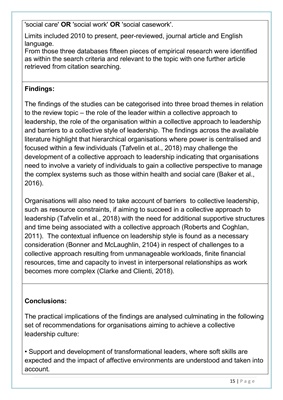
15 | P a g e
'social care' OR 'social work' OR 'social casework'.
Limits included 2010 to present, peer-reviewed, journal article and English
language.
From those three databases fifteen pieces of empirical research were identified
as within the search criteria and relevant to the topic with one further article
retrieved from citation searching.
Findings:
The findings of the studies can be categorised into three broad themes in relation
to the review topic - the role of the leader within a collective approach to
leadership, the role of the organisation within a collective approach to leadership
and barriers to a collective style of leadership. The findings across the available
literature highlight that hierarchical organisations where power is centralised and
focused within a few individuals (Tafvelin et al., 2018) may challenge the
development of a collective approach to leadership indicating that organisations
need to involve a variety of individuals to gain a collective perspective to manage
the complex systems such as those within health and social care (Baker et al.,
2016).
Organisations will also need to take account of barriers to collective leadership,
such as resource constraints, if aiming to succeed in a collective approach to
leadership (Tafvelin et al., 2018) with the need for additional supportive structures
and time being associated with a collective approach (Roberts and Coghlan,
2011). The contextual influence on leadership style is found as a necessary
consideration (Bonner and McLaughlin, 2104) in respect of challenges to a
collective approach resulting from unmanageable workloads, finite financial
resources, time and capacity to invest in interpersonal relationships as work
becomes more complex (Clarke and Clienti, 2018).
Conclusions:
The practical implications of the findings are analysed culminating in the following
set of recommendations for organisations aiming to achieve a collective
leadership culture:
• Support and development of transformational leaders, where soft skills are
expected and the impact of affective environments are understood and taken into
account.